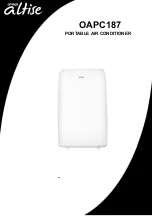
7
SYSTEM START UP
CAUTION
POSSIBLE REFRIGERANT LEAK
To avoid a possible refrigerant leak, open the service valves
until the top of the stem is 1/8” from the retainer.
When opening valves with retainers, open each valve
only until the top of the stem is 1/8” from the retainer. To
avoid loss of refrigerant, DO NOT apply pressure to the
retainer. When opening valves without a retainer remove
service valve cap and insert a hex wrench into the valve
stem and back out the stem by turning the hex wrench
counterclockwise. Open the valve until it contacts the rolled
lip of the valve body.
NOTE: These are not back-seating valves. It is not
necessary to force the stem tightly against the
rolled lip.
NOTE: Power must be supplied to the outdoor
units containing ECM motors before the power is
applied to the indoor unit. Sending a low voltage
signal without high voltage power present at
the outdoor unit can cause malfunction of the
control module on the ECM motor.
Adequate refrigerant charge for the matching HSVTC
evaporator coil and 15 feet of lineset is supplied with
the condensing unit. If using evaporator coils other than
HSVTC coil, it may be necessary to add or remove
refrigerant to attain proper charge. If line set exceeds 15
feet in length, refrigerant should be added at .6 ounces per
foot of liquid line.
NOTE: Charge should always be checked using
superheat when using a piston and subcooling
when using TXV equipped indoor coil to verify
proper charge.
Break vacuum by fully opening liquid service valve.
After the refrigerant charge has bled into the system,
open the suction service valve. The service valve cap is
the secondary seal for the valves and must be properly
tightened to prevent leaks. Make sure cap is clean and
apply refrigerant oil to threads and sealing surface on
inside of cap. Tighten cap finger-tight and then tighten
additional 1/6 of a turn (1 wrench flat), or to the following
specification, to properly seat the sealing surfaces.
1.
3/8” valve to 5 - 10 in-lbs
2.
5/8” valve to 5 - 20 in-lbs
3.
3/4” valve to 5 - 20 in-lbs
4.
7/8” valve to 5 - 20 in-lbs
Do not introduce liquid refrigerant from the cylinder into
the crankcase of the compressor as this may damage the
compressor.
CAUTION
POSSIBLE REFRIGERANT LEAK
To avoid a possible refrigerant leak, open the service valves
until the top of the stem is 1/8” from the retainer.
1. Break vacuum by fully opening liquid and suction
base valves.
2. Set thermostat to call for cooling. Check indoor and
outdoor fan operation and allow system to stabilize
for 10 minutes for fixed orifices and 20 minutes for
expansion valves.
Charge Verification
WARNING
REFRIGERANT UNDER PRESSURE!
•
Do not overcharge system with refrigerant.
•
Do not operate unit in a vacuum or at negative pressure.
Failure to follow proper procedures may cause property
damage, personal injury or death.
CAUTION
Use refrigerant certified to AHRI standards. Used
refrigerant may cause compressor damage. Most portable
machines cannot clean used refrigerant to meet AHRI
standards.
NOTICE
Violation of EPA regulations may result in fines or other
penalties.
CAUTION
Damage to the unit caused by operating the compressor with
the suction valve closed is not covered under the warranty
and may cause serious compressor damage.
Final Charge Adjustment
Airflow and Total Static Pressure for the indoor unit should
be verified before attempting to charge system.
1.
Total static pressure is .5” WC or less.
2.
Airflow is correct for installed unit.
3.
Airflow tables are in the installation manual and Spec
Sheet for Indoor Unit.
4.
Complete charging information are in Service Manual
RSD6200006R**.


































